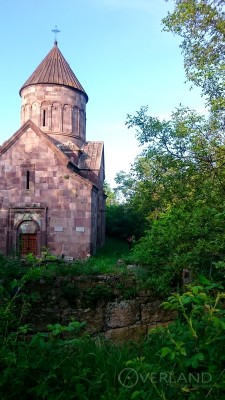Rebuilt in the XII century, the monastery of Makaravank or Agravavank rises on the picturesque, forested mountain Paitatap, as if merging with this magical beauty
The monastery is located in Northern Armenia, in the Tavush region of Armenia, a few kilometers up from the village of Achajur. When looking at the monastery from the village, you can only see the cross of the Church of St. Mary visible behind the trees.

There are two interesting legends associated with the monastery, which are related to the two names of the monastery.
According to one of them, Makaravank was built by a master named Makar with his only son. The son sharpened and decorated stones, and the father built walls. Day after day, the walls rose, and my father rose from the ground. He spent the night on the walls of the monastery. But once the master noticed that the stones on the wall do not look like each other and the patterns do not match. He wanted to call his son to find out what was wrong. He was told that his son was ill, but Makar realized that his son was no longer there. He continued the construction of the temple and after finishing the construction, climbed to the top of the dome and threw himself from there. He was buried at the monastery and from that day the monastery became known as Makaravank.
According to another legend, once the masters who built the monastery prepared their own dinner. Suddenly the Raven began to circle over the cauldron where Arisa was cooking. When the builders opened the cauldron for dinner, the Raven fell like a stone into the interior. Dejected builders poured food on the ground, saw that a snake was hidden at the bottom of the cauldron. So the Raven saved the builders of the monastery and the name Agravavank appeared-the Raven monastery (agrav-Raven).
Currently, the Makaravank preserved Church. Gregory the Illuminator, the main Church. Notre Dame, porch of the little Church of SV. The virgin, a chapel, a spring, ancient walls, tombs and living quarters.
The oldest structure of the monastery complex is the Church of St. Gregory the Illuminator, presumably rebuilt in the XII century from the chapel of the V century. It has a cruciform structure inside and a rectangular structure outside. The altar is decorated with floral and geometric elegant patterns.
The little Church of our lady was built in 1198. The Church is cruciform inside and octagonal outside. Window frames and niches are decorated with bas-reliefs of birds, tigers, and scenes of an eagle and a dragon fighting.
The main Church of our lady was built in 1205. The Church has a type of domed hall-rectangular on the outside, cruciform on the inside. Four powerful five-sided pylons are connected by high arches, forming a span in the center, on which the dome is built. The unique ornaments that adorn the altar belong to the medieval masterpieces of Armenian architecture.
The Makaravank monastery has great cultural, spiritual and architectural significance for Armenia.